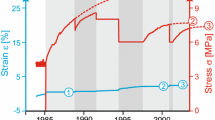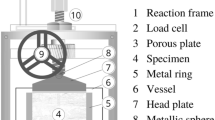Abstract
Traditionally, land subsidence resulting from groundwater over-pumping has often been described by the theory of consolidation. The mechanism of land subsidence due to the dehydration of clay minerals has not been well addressed. Therefore, this study develops a smectite dehydration model to describe the effect of the release of water from the smectite interlayer upon land subsidence. Using a thermodynamic solid-solution model and laboratory studies of clay-water systems, a complete description of the dehydration relationships among the swelling pressure, basal spacing and mw/mc in a Na-smectite water system at 25°C under variable pressure conditions was derived. Accordingly, the evaluation model of the ‘hydration state of smectite’, and the ‘solid-solution model of smectite dehydration’ were formulated rigorously. These two models were applied to quantify the effects of smectite dehydration on the accumulated land subsidence in the Yun Lin offshore industrial infrastructure complex and in the Tai-Shi area. The result reveals that smectite dehydration is of importance in assessing and predicting land subsidence in a shallow sedimentary basin.
Similar content being viewed by others
References
Anderson, D.M. and Low, P.F. (1958) The density of water adsorbed by lithium-, sodium-, and potassium-bentonite. Proceedings of the Soil Science Society of America, 11, 99–103.
Audet, D.M. (1995) Mathematical modeling of gravitational compaction and clay dehydration in thick sediment layers. Geophysical Journal International, 122, 283–298.
Bethke, C.M. (1986) Inverse hydrological analysis of the distribution and origin of Gulf coast-type geopressure zone. Journal of Geophysical Research, 91, 6535–3545.
Biot, M.A. (1941) General theory of three dimensional consolidation. Journal of Applied Physics, 12, 155–164.
Biot, M.A. (1955) Theory of elasticity and consolidation for a porous anisotropic solid. Journal of Applied Physics, 26, 182–185.
Brown, K.M. and Ransom, B. (1996) Porosity corrections for smectite-rich sediments-impact on studies of compaction, fluid generation. Geology, 24, 843–846.
Bruce, C.H. (1984) Smectite dehydration — Its relation to structure development and hydrocarbon accumulation in northern Gulf to Mexico Basin. American Association of Petroleum Geologists Bulletin, 68, 673–683.
Burst, J.F. (1969) Diagenesis of Gulf coast clayey sediments and its possible relation to petroleum migration. American Association of Petroleum Geologists Bulletin, 53, 73–93.
Central Geological Survey (1999) Project of groundwater monitoring network in Taiwan during first stage — Research report of Chou-Shui River alluvial fan: Water Resources Bureau Report, Ministry of Economic Affairs, ROC, 130.
Colten-Bradley, V.A. (1987) Role of pressure in smectite dehydration — Effects on geopressure and smectite-to-illite transformation. The American Association of Petroleum Geologists Bulletin, 71, 1414–1427.
Das, B.M. (1990) Principles of Geotechnical Engineering, 2nd edition. PWS-Kent, Boston, USA, 350 pp.
Fitts, T.G. and Brown, K.M. (1999) Stress-induced smectite dehydration: ramifications for patterns of freshening and fluid expulsion in the N. Barbados accretionary wedge. Earth and Planetary Science Letters, 172, 179–197.
Foster, M.D. (1953) Geochemical studies of clay minerals, II: Relation between ionic substitution and swelling in montmorillonites. American Mineralogist, 38, 994–1006.
Fu, M.H., Zhang, Z.Z. and Low, P.F. (1990) Changes in the properties of a montmorillonite-water system during the adsorption and desorption of water: hysteresis. Clays and Clay Minerals, 38, 485–492.
Harward, M.E. and Brindley, G.W. (1966) Swelling of synthetic smectites in relation to lattice substitutions. Pp. 209–222 in: 13th National Conference of Clays and Clay Minerals Proceedings.
Hawkins, R.K. and Egelstaff, P.A. (1980) Interfacial water structure in montmorillonite from neutron diffraction experiments. Clays and Clay Minerals, 28, 19–28.
Industry Bureau (2000) Yun Lin offshore industrial infrastructure complex development project, part IV: land subsidence monitoring and analysis. Industry Bureau Report, Ministry of Economic Affairs, ROC, 130.
Johnson, J.W., Oelkers, E.H. and Helgeson, H.C. (1992) SUPCRT92: Software package for calculating the standard molal thermodynamic properties of minerals, gases, aqueous species, and reactions among them as functions of temperature and pressure. Computers and Geosciences, 18, 899–947.
Keren, R. and Shainberg, I. (1975) Water vapor isotherm and heat of immersion of Na/Ca-montmorillonite systems I: homoionic clay. Clays and Clay Minerals, 23, 193–200.
Keren, R. and Shainberg, I. (1980) Water vapor isotherm and heat of immersion of Na- and Ca-montmorillonite systems III: Thermodynamics. Clays and Clay Minerals, 28, 204–210.
Liu, C.W., Lin, W.S., Shang, C. and Liu, S.H. (2001) The effect of clay dehydration on land subsidence in Yun-Lin coastal area, Taiwan. Environmental Geology, 40, 518–527.
Low, P.F. (1979) Nature and properties of water in montmor-illonite-water systems. Soil Science Society of America Journal, 43, 651–658.
Martin, R.T. (1962) Adsorbed water on clay — a review. Pp. 28–70 in: 9th National Conference on Clays and Clay Minerals Proceedings. Pergamon Press, New York.
Mitchell, J.K. (1993) Fundamentals of Soil Behavior, 2nd edition. John Wiley and Sons, Inc., New York, 437 pp.
Mooney, R.W., Keenan, A.C. and Wood, L.A. (1952) Adsorption of water vapor by montmorillonite. Journal of the American Chemical Society, 74, 1367–1374.
Norrish, K. (1954) The swelling of montmorillonite. Faraday Society, London, Discussions, 18, 353–359.
Norrish, K. and Quirk, J.P. (1954) Crystalline swelling of montmorillonite: Use of electrolytes to control swelling. Nature (London), 173, 255–256.
Oliphant, J.L. and Low, P.F. (1982) The relative partial specific enthalpy of water in montmorillonite water systems and its relation to the swelling of these systems. Journal of Colloid and Interface Science, 89, 366–373.
Ormerod, E.C. and Newman, A.C.D. (1983) Water sorption on C3 saturated clays II; internal and external surfaces of montmorillonite. Clay Minerals, 18, 289–299.
Perry, E.A. and Hower, J. (1972) Late-stage dehydration in deeply buried pelitic sediments. The American Association of Petroleum Geologists Bulletin, 56, 2013–2021.
Posner, A.M. and Quirk, J.P. (1964) Changes in basal spacing of montmorillonite in electrolyte solution. Journal Colloid and Interface Science, 19, 789–812.
Powers, M.C. (1967) Fluid-release mechanism in compacting marine mudrocks and their importance in oil exploration. The American Association of Petroleum Geologists Bulletin, 51, 1240–1254.
Ransom, B. and Helgeson, H.C. (1989) On the correlation of expandability with mineralogy and layering in mixed-layer clays. Clay and Clay Minerals, 37, 189–191.
Ransom, B. and Helgeson, H.C. (1994a) A chemical and thermodynamic model of aluminous dioctahedral 2:1 layer clay minerals in diagenetic processes: regular solution representation of interlayer dehydration in smectite. American Journal of Science, 294, 449–484.
Ransom, B. and Helgeson, H.C. (1994b) Estimation of the standard molal heat capacities, entropies, and volumes of 2:1 clay minerals. Geochimica et Cosmochimica Acta, 58, 4537–4547.
Ransom, B. and Helgeson, H.C. (1995) A chemical and thermodynamic model of aluminous dioctahedral 2:1 layer clay minerals in diagenetic processes: dehydration of diotahedral aluminous smectite as a function of temperature and depth in sedimentary basins. American Journal of Science, 295, 245–281.
Rowland, R.A., Weiss, E.J. and Bradley, W.F. (1956) Dehydration of monoionic montmorillonites. Pp. 85–95 in: Proceedings of the 4th National Conference on Clays and Clay Minerals, New York.
SYSTAT (2001) Table Curve 2D. Version 5.01, Systat Software Inc., Richmond, California.
Terzaghi, K. (1925) Erdbaumechanik auf bodenphysikalischer grundlage. Deuticke, Vienna, 399p.
van Olphen, H. (1963) Compaction of clay sediments in the range of molecular particle distances. Pp. 178–187 in: Proceeding of the 11th National Conference on Clays and Clay Minerals. National Academy of Sciences, National Research Council, Washington, D.C.
Water Resources Bureau (2001a) Land subsidence monitoring and analysis in Taiwan. Water Resources Bureau Report, Ministry of Economic Affairs, ROC, 900.
Water Resources Bureau (2001b) Analysis of the regional hydrogeological characteristics. Chou-Shui River alluvial fan: Water Resources Bureau Report, Ministry of Economic Affairs, ROC, 164.
Wu, T.C., Bassett, W.A., Huang, W.L., Guggenheim, S. and Koster van Groos, A.F. (1997) Montmorillonite under high H2O pressures: Stability of hydrate phases. Rehydration hysteresis, and the effect of interlayer cations. American Mineralogist, 82, 69–78.
Yasyerli, N. Dogu, G., Dogu, T. and McCoy, B.J. (1999) Pulse-response study for the humidity effect on sorption of ethyl bromide on clays. American Institute of Chemical Engineering Journal, 45, 291–298.
Zhang, F., Low, P.F. and Roth, C.B. (1995) Effect of monovalent, exchangeable cations and electrolytes on the relation between swelling pressure and interlayer distance in montmorillonite. Journal of Colloid and Interface Science, 173, 34–41.
Zhang, Z.Z. and Low, P.F. (1989) Relation between the heat of immersion and the initial water content of Li-, Na, and K-montmorillonite. Journal of Colloid and Interface Science, 133, 461–472.
Author information
Authors and Affiliations
Corresponding author
Rights and permissions
About this article
Cite this article
Liu, CW., Lin, WS. A Smectite Dehydration Model in a Shallow Sedimentary Basin: Model Development. Clays Clay Miner. 53, 55–70 (2005). https://doi.org/10.1346/CCMN.2005.0530107
Received:
Revised:
Published:
Issue Date:
DOI: https://doi.org/10.1346/CCMN.2005.0530107




